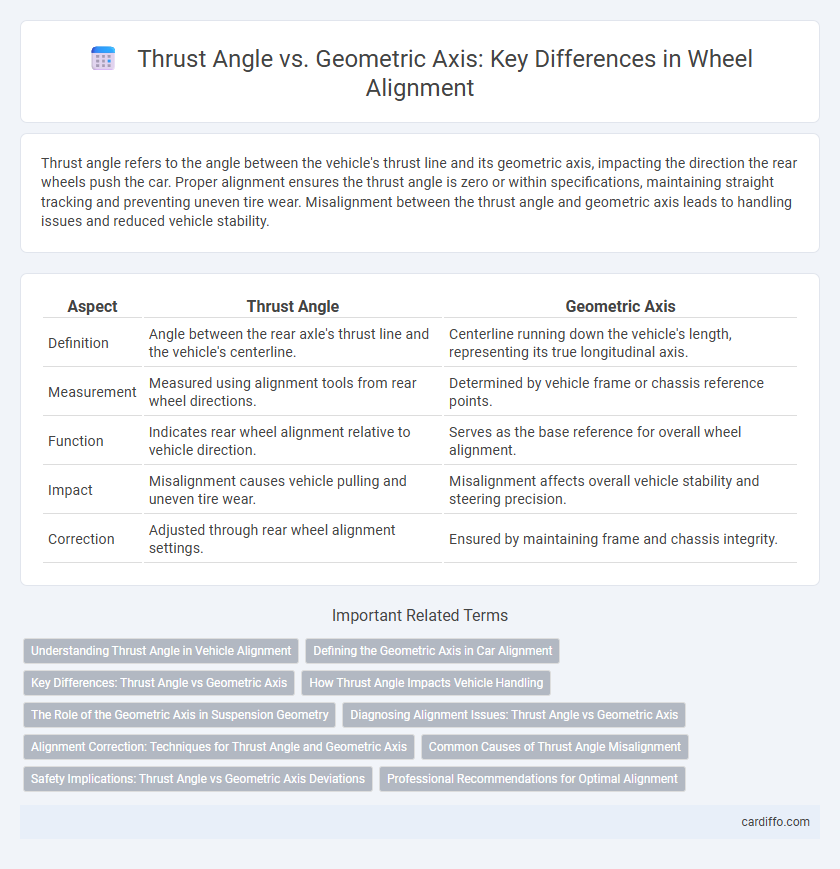Thrust angle refers to the angle between the vehicle's thrust line and its geometric axis, impacting the direction the rear wheels push the car. Proper alignment ensures the thrust angle is zero or within specifications, maintaining straight tracking and preventing uneven tire wear. Misalignment between the thrust angle and geometric axis leads to handling issues and reduced vehicle stability.
Table of Comparison
| Aspect | Thrust Angle | Geometric Axis |
|---|---|---|
| Definition | Angle between the rear axle's thrust line and the vehicle's centerline. | Centerline running down the vehicle's length, representing its true longitudinal axis. |
| Measurement | Measured using alignment tools from rear wheel directions. | Determined by vehicle frame or chassis reference points. |
| Function | Indicates rear wheel alignment relative to vehicle direction. | Serves as the base reference for overall wheel alignment. |
| Impact | Misalignment causes vehicle pulling and uneven tire wear. | Misalignment affects overall vehicle stability and steering precision. |
| Correction | Adjusted through rear wheel alignment settings. | Ensured by maintaining frame and chassis integrity. |
Understanding Thrust Angle in Vehicle Alignment
Thrust angle in vehicle alignment refers to the angle formed between the vehicle's geometric centerline and the direction the rear wheels are pointing, which directly impacts handling and tire wear. Properly aligning the thrust angle ensures that the rear wheels follow the front wheels correctly, maintaining vehicle stability and preventing uneven tire wear. Incorrect thrust angle can cause the vehicle to pull to one side, reducing fuel efficiency and increasing stress on suspension components.
Defining the Geometric Axis in Car Alignment
The geometric axis in car alignment refers to an imaginary line drawn through the centers of the front and rear wheel hubs, representing the vehicle's true directional path. It serves as a critical reference for measuring thrust angle, which is the angle between the rear axle's direction and the vehicle's geometric centerline. Accurate definition of the geometric axis ensures proper alignment settings, optimizing handling, tire wear, and overall vehicle stability.
Key Differences: Thrust Angle vs Geometric Axis
Thrust angle refers to the angle between the vehicle's centerline and the direction the rear wheels push the car, crucial for proper wheel alignment and vehicle stability. The geometric axis is the straight line determined by the suspension and steering components, representing the ideal alignment path of the vehicle. Key differences include that thrust angle affects rear wheel alignment impacting straight-line tracking, while the geometric axis relates to the overall chassis and front wheel alignment for balanced handling.
How Thrust Angle Impacts Vehicle Handling
Thrust angle, the angle between the vehicle's geometric axis and the direction the rear wheels point, directly affects vehicle handling by influencing tracking and stability. A misaligned thrust angle causes the vehicle to pull to one side, increasing tire wear and reducing steering response accuracy. Properly aligning the thrust angle ensures optimal tire grip, enhances directional control, and improves overall driving safety.
The Role of the Geometric Axis in Suspension Geometry
The geometric axis serves as the primary reference line in suspension geometry, defining the intended orientation of suspension components relative to the vehicle frame. Its role is crucial in establishing proper thrust angle, which impacts rear wheel alignment and overall vehicle stability. Accurate alignment of the geometric axis ensures optimized handling, reduced tire wear, and improved directional control.
Diagnosing Alignment Issues: Thrust Angle vs Geometric Axis
Thrust angle measurement is critical for diagnosing vehicle alignment issues by identifying the angle between the rear axle's direction and the geometric axis of the vehicle. A misaligned thrust angle often causes uneven tire wear and handling problems due to the rear wheels being out of sync with the front wheels. Comparing thrust angle to the geometric axis helps technicians pinpoint rear-end alignment faults that standard front-end alignment checks may overlook.
Alignment Correction: Techniques for Thrust Angle and Geometric Axis
Alignment correction techniques for thrust angle versus geometric axis focus on precise measurement and adjustment to ensure proper vehicle handling and tire wear. Utilizing laser alignment systems or computerized diagnostic tools enhances accuracy in detecting deviations between the thrust line and geometric axis. Correcting these misalignments involves adjusting rear wheel angles and suspension components to realign the thrust vector with the vehicle's geometric centerline.
Common Causes of Thrust Angle Misalignment
Thrust angle misalignment commonly arises from worn suspension components, damaged or bent steering knuckles, and improper installation of wheel bearings. Uneven tire wear and impacts from potholes or curbs frequently contribute to deviations between the thrust angle and the geometric axis. Regular inspection of the chassis and suspension system is essential to detect and correct these issues, maintaining proper vehicle alignment and handling.
Safety Implications: Thrust Angle vs Geometric Axis Deviations
Deviations between the thrust angle and geometric axis can lead to uneven tire wear and compromised vehicle stability, increasing the risk of loss of control during high-speed maneuvers. Misalignment in the thrust angle often causes the rear wheels to steer improperly relative to the front, resulting in unpredictable handling and reduced traction. Regular inspection and correction of thrust angle versus geometric axis alignment are critical to maintaining optimal safety and preventing premature suspension component failure.
Professional Recommendations for Optimal Alignment
Professional recommendations for optimal alignment emphasize minimizing thrust angle deviation to prevent uneven tire wear and improve vehicle handling. Precision measurement tools, such as laser alignment systems, ensure the thrust angle closely matches the geometric axis, maintaining proper rear wheel tracking. Regular alignment checks, especially after suspension repairs or impacts, are crucial for sustaining optimal thrust angle alignment and overall vehicle performance.
Thrust Angle vs Geometric Axis Infographic

 cardiffo.com
cardiffo.com